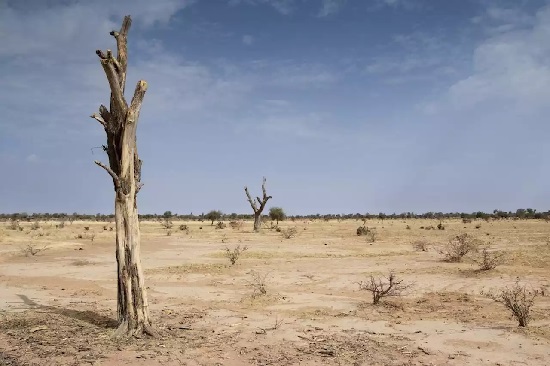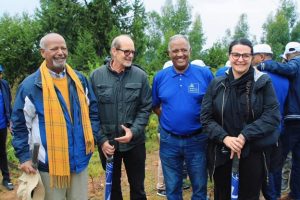
BY MENGESHA AMARE
The very fate of the earth is undeniably in the hands of its sons and daughters as it enjoys greenery when they well eye at or plant trees, and suffers from dilapidation when they recklessly act up on it.
Of course, eying at the planet on the one hand entails planting tree seedlings, nurturing them well and giving forests and green areas value as all these can confidently prolong life—the time living things stay on earth, and recklessly act up on the planet comes up with a senseless move against its wellbeing applying cutting of trees, leaving places empty, leveling leeway to soil erosion and torrential rainfall on the other. Here, unwise use of forest resources, cattle overgrazing on a limited plots of land, are highly attributable to severe land degradation which in turn immensely contributes to a grand global threat—climate change—which come up with the expansion of barren land and infertile facets of the universe in return.
So long as the earth is at present facing risk of being entirely deserted, it is really high time for dwellers of the planet to wake up about to where the world is going these days. If each country of any continent is well committed to discharge their respective responsibility regarding making places green, the cumulative effect can help the whole universe have a greenery scene to look at, clean air to breathe, marvelous places to visit and the likes.
There are of course countries like Ethiopia stand for this sacred deed in a bid to save the world from being devoid of trees, plants, foliage and shrubbery—flora combined against desolate.
Making the thrived face of the earth prevail over the tarnished part is at human beings palm if everyone is well aware of the negative impacts of degraded land and eroded soil and firmly committed to cover the planet green.
Apart from its effort to cover lands with green plants at every part of the nation, Ethiopia has been endeavoring to distribute tree seedlings to neighboring counties to grow together—an emblem of regional integration indeed. It is working hard to attain the set targets and hit the expected outcomes—adorning Ethiopia thereby balancing nature. Ethiopia is now becoming a new hotspot for optimistically framed environmental and social moves. Its population at home and abroad move in unison to confidently contain the impact of rapid population growth, increased urban pressures, poverty and dependence on the agricultural sector and to effectively deal with environmental and climate crises, which potentially lead to growing migration and shared jeopardies.
Taking Ethiopians effort from corner to corner to make the green legacy initiated by Abiy Ahmed (PhD) sustainable, this writer approached Amsalu Gobena, an environmentalist, graduated from AAU, with a view to adding value to the concept the piece holds.
He said, “No doubt drought, which has a direct bearing to lack of forests on earth can exacerbate socio-economic problems and lead to disruptions in food supply and increase vulnerability of rural communities, as well as massive return of labor migrants and loss of jobs in urban areas. Hence, everybody has to attach due emphasis to tree plantation and cherishing them as they give life.”
Hence, major policy interventions and changes in management approaches are needed in order to prevent and reverse the repercussions of barren lands. Such interventions should be implemented at local, regional as well as universal scales with the active engagement of top national leaders, district administrators, stakeholders and local communities of every country.
Yes, prevention is much more cost-effective than rehabilitation, and this should be taken into account in policy decisions as it helps eradicate extreme poverty and ensure environmental sustainability among other purposes, he added.
“Not only is Ethiopia planting trees and providing its neighbors with a billion tree saplings, but it is also applying land degradation preventive actions such as employing integrated land and water management to protect soils from erosion, protecting the vegetative cover, which can be a major instrument for soil conservation against wind and water erosion, putting a combination of traditional practices with locally acceptable and locally adapted land use technologies into effect as well as raising public awareness about the significance of protecting environment and nurturing nature,” he said.
True, effective restoration and rehabilitation infertile lands demand firm leadership commitment, combination of policies and technologies as well as active involvement of local communities across the nation.
As to him, other rehabilitation practices include investing in land through practices such as terracing and other counter-erosion measures, control of invasive species like Emboch, chemical and organic nutrient replenishment and reforestation are the very pillars of making green legacy sustainable.
Responding to the question posed on him about ‘strategies to reduce desertification’, Amsalu said, “Desertification can be reduced by planting more trees, improving the quality of soil via reducing the number of grazing animals and growing crops in the way that can improve the quality of the soil, storing water in dams during rainy season and using to irrigate crops during the dry season etc.”
It is also pivotal to employ sustainable land management (SLM), which is ‘the use of land resources, including soils, water, animals and plants, for the production of goods to meet changing human needs thereby simultaneously ensuring the long-term productive potential of these resources and the maintenance of their environmental functions’, he opined.
The youth and farmers themselves see no future on the land without diligently taking care of it at present. Cognizant of the fact that land degradation and poverty are directly proportional, the government hat to heavily invest in land restoration and agricultural improvement programs. When public capacity is built and land is restored, resilience and opportunities increase. In the process of land restoration, people generally begin to value their land and to take greater care of it. The more they take care of it the more it can produce, and the more valuable it becomes.
He further stated that planting trees across the desert areas is of paramount importance in coming up with greater capacity to combat drought and enjoy the fruits of a safe planet.
“Ethiopia’s effort is not necessarily a local move to adorn its landscapes, but it will be a mosaic of land use practices that ultimately will meet the expectations of continental greenery. It has to be expanded to other countries of the continent of Africa and to those of other continents of the world,” Amsalu opined.
It is really considered as a sign of being greedy not to acknowledge the unreserved efforts of Ethiopia’s leaders. Undeniably, the use of environmental protection and proper utilization of pieces of lands is vividly reflected by the practical deeds of Prime Minister Abiy Ahmed (Ph.D). Since two or so years traveling through Addis Ababa has been much more likeable and forces people to salute their leaders comparing what was being done with the actions of the reformist administration.
Ethiopia is now well exploiting the significance of afforestation or reforestation as it is an effective technology to reverse land degradation and rehabilitate degraded land, and is an effective climate change mitigation strategy.
In a nutshell, the main purpose of tree plantation, which has been undertaken in Ethiopia since 2018, is now becoming a culture inculcated in the minds of citizens and started helping reduce soil erosion. It is also of paramount importance in increasing soil fertility to foster forest regrowth, improve the potential wood extraction in the future and enlighten the visual landscape as well as enable the nation to secure food self-sufficiency as it has a direct bearing to the meaningful national plan to cumulatively buttress home grown economy.
Every country of the world has to follow Ethiopia’s footsteps as the latter is endeavoring to make the thrived facet of the earth outweighs.
THE ETHIOPIAN HERALD JULY 27/2021





